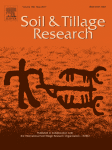Ver ítem
- xmlui.general.dspace_homeCentros Regionales y EEAsCentro Regional La Pampa - San LuisEEA AnguilArtículos científicosxmlui.ArtifactBrowser.ItemViewer.trail
- Inicio
- Centros Regionales y EEAs
- Centro Regional La Pampa - San Luis
- EEA Anguil
- Artículos científicos
- Ver ítem
Soil type, land-use and -management as drivers of root-C inputs and soil C storage in the semiarid pampa region, Argentina
Resumen
The objective of the study was to assess the effect of soil type, land-use and -management on root-C inputs and soil carbon storage in the central semiarid pampa region, Argentina. Twenty-one sites were assessed with different land uses (agriculture, natural grassland and pasture) and textures (sand, loamy sand, sandy loam and loam). Root and shoot biomass, and soil properties including texture, total C and N, particulate C, mineral associated C, pH, bulk
[ver mas...]
The objective of the study was to assess the effect of soil type, land-use and -management on root-C inputs and soil carbon storage in the central semiarid pampa region, Argentina. Twenty-one sites were assessed with different land uses (agriculture, natural grassland and pasture) and textures (sand, loamy sand, sandy loam and loam). Root and shoot biomass, and soil properties including texture, total C and N, particulate C, mineral associated C, pH, bulk density and available phosphorus were determined. Results showed that land use conditioned the magnitude of C input in the system while texture limited C storage. Higher root to shoot ratio (5.1–7.6:1) was observed in natural grassland than in pasture (2–4.2:1) and agriculture (0.6−1:1). Positive linear relationships were found between soil C and silt plus clay content with increments of C storage of 4, 2 and 1% under natural grassland, pasture and agriculture respectively. Linear and saturation models were performed for the relationship between soil organic matter and root-C for each soil type and the first 0.20m depth. Sandy loam soils achieved C saturation level at 65 Mg C ha−1 defined by maximum values under natural grasslands with C storage capacity of 34 Mg C ha−1. Soils with silt plus clay content lower than 20% (sand and loamy sand textures) also showed an upper limit of 16.6 Mg ha−1 (equivalent to 0.6% C). In contrast, loam soils showed no -saturating behavior (linear response) with increments of 14 Mg C ha−1 per unit of root-C input. Particulate C increased with increasing root-C inputs in loam and sandy loam soils with no change in mineral associated C. The rate at which root-C was transformed to particulate C was 11.8 and 7.3 Mg Cp Mg root-C−1 for loam and sandy loam soils respectively. Our results showed that soil type and climate are crucial for determining C sequestration capacity of soils, and root inputs, more than aboveground biomass, should be considered when deciding appropriate soil management for enhanced C storage.
[Cerrar]

Autor
Frasier, Ileana;
Quiroga, Alberto Raul;
Fernandez, Romina;
Alvarez, Cristian;
Gomez, Florencia;
Noellemeyer, Elke;
Scherger, Eric Daniel;
Gili, Adriana;
Fuente
Soil & Tillage Research 192 : 134-143 (September 2019)
Fecha
2019-09-01
Editorial
Elsevier
ISSN
0167-1987
Formato
pdf
Tipo de documento
artículo
Palabras Claves
Derechos de acceso
Restringido
 Excepto donde se diga explicitamente, este item se publica bajo la siguiente descripción: Creative Commons Attribution-NonCommercial-ShareAlike 2.5 Unported (CC BY-NC-SA 2.5)
Excepto donde se diga explicitamente, este item se publica bajo la siguiente descripción: Creative Commons Attribution-NonCommercial-ShareAlike 2.5 Unported (CC BY-NC-SA 2.5)

